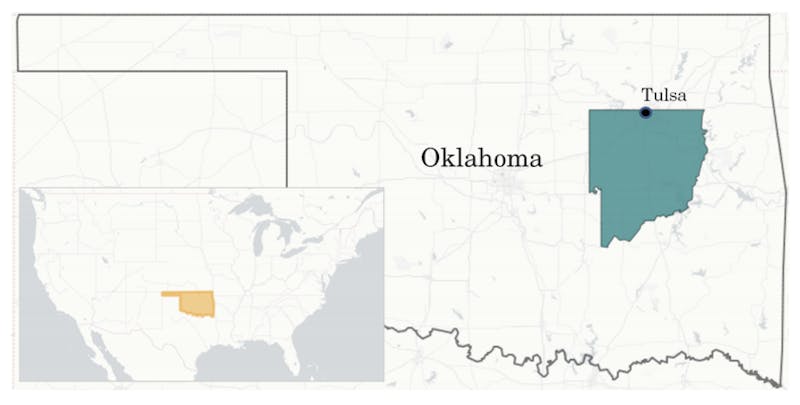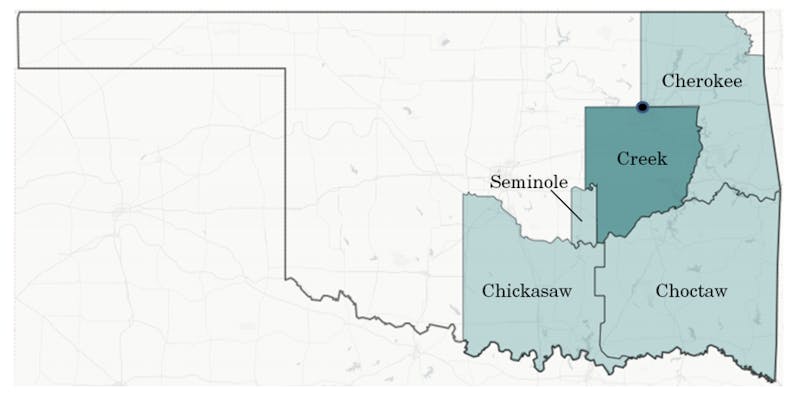In a legal quirk for the ages, a 1990s capital murder case involving two Native Americans could restore tribal sovereignty to almost half of Oklahoma for the first time in a century—unless the Supreme Court intervenes, that is.
The federal government asked the justices last Friday to review and reverse the Tenth Circuit Court of Appeals’ decision in Royal v. Murphy, an unusual case in which Patrick Murphy, a death-row inmate and member of the Muscogee Creek Nation, claimed Oklahoma lacked the jurisdiction to try him for the murder of another tribal member on what was part of the Creek Nation’s reservation.
Until now, state and federal officials assumed those boundaries no longer existed. To prepare Oklahoma for statehood in the late nineteenth century, Congress stripped the Creek Nation and other tribes in the territory of their courts, governments, and laws. The federal government also compelled the Creek to convert their tribal lands into allotments for private ownership by the tribe’s members, with the surplus land to be sold to white settlers. When Oklahoma joined the Union in 1907, state and federal power held total sway.
A three-judge panel in the Tenth Circuit ruled last summer, however, that Congress never explicitly abolished the Creek Nation’s reservation along the way. Under the Supreme Court’s precedents, the judges concluded, the oversight left the reservation legally intact until the present day. As a result, the panel ruled that the defendant’s murder case could only be tried in federal courts, like other major crimes between Native Americans on tribal land under current federal law.
That was good news for Murphy, who could be retried in federal court if the ruling stands. But the Tenth Circuit’s decision has ramifications beyond a single capital case. It effectively restores the Creek Nation’s sovereign territory after a century in abeyance, handing the tribe a significant and perhaps unintentional legal victory. (Tribal officials did not return a request for comment.) The ruling also raises the possibility of sovereignty claims by other Oklahoma tribes, including the other four of what are known as the Five Civilized Tribes.
“This is something that almost all other tribes in this country have outside of Oklahoma, and this would put Oklahoma tribes on an equal footing with Indian tribes elsewhere,” Judith Royster, a University of Tulsa law professor who specializes in Indian law, told me.


A reservation delineated by the Creek Nation’s 1866 boundaries alone would fill 4,600 square miles of eastern Oklahoma and include more than 750,000 inhabitants, the state of Oklahoma told the Supreme Court in its petition for review. “The 1866 boundaries also include most of Tulsa, the State’s second largest city and home to more than 403,000 Oklahomans,” the state told the court. “A reconstituted Creek territory would be by far the largest Indian reservation by population in the United States.” If the ruling is applied to the rest of the Five Tribes, the state added, just over 40 percent of Oklahoma would become Indian country.
If the Tenth Circuit’s ruling stands, the state’s criminal jurisdiction in that territory would be reduced to minor offenses like traffic violations and crimes against non-Indians. Federal and tribal courts would take over all other cases, with serious crimes left to the federal government to investigate and prosecute. State officials cast the loss of jurisdiction in dire terms, especially if the Murphy ruling is applied to other tribes. “Stripping Oklahoma of criminal jurisdiction over all Indians in this densely populated area, or even worse, in the entire eastern half of the state, would render Oklahoma a fractured, second-class state,” Oklahoma officials told the Supreme Court.
Solicitor General Noel Francisco, who represents the federal government at the Supreme Court, joined the fight on Oklahoma’s side in a brief filed last week. The justices routinely invites solicitors general to weigh in on major potential cases that could affect federal law or foreign policy. This time, however, Francisco took the rare step of filing one before the court asked him for it, a move that underscores the government’s urgent interest in the case.
“The Tenth Circuit’s reasoning could well extend to the original territories of each of the Five Tribes, expanding federal jurisdiction over nearly all of eastern Oklahoma,” the solicitor general’s office warned the court. “And it could have significant implications for application of state tax and other civil laws to Indians in the former Indian Territory. The decision ... thus threatens to disrupt the distribution of governmental authority in nearly half of Oklahoma.”
Groups representing oil and gas companies and the state’s business community also urged the Supreme Court to intervene, framing the situation as economically disruptive. “By effectively declaring half the state to be Indian country, the Tenth Circuit’s decision will upend practically every aspect of Oklahoma’s legal and regulatory regime,” the Oklahoma Independent Petroleum Association complained in its brief.
Royster disputed that interpretation, telling me that the immediate impact on civil matters for Oklahomans would be minimal. “Nothing’s going to happen to my property, nothing’s going to happen to my day-to-day life,” she said. “Nobody except criminals and the federal courts are going to see any immediate changes because of this.”
Those effects are already apparent: State officials told the court last month that at least 46 defendants had already invoked the ruling in lawsuits challenging their own convictions.
The case’s disturbing origins didn’t hint at its unusual outcome. In 1999, an Oklahoma jury found Murphy guilty of mutilating and murdering his girlfriend’s ex-boyfriend, George Jacobs. Both men were members of the Creek Nation and the crime occurred within the 1866 borders. Jurors handed Murphy a death sentence, kicking off a nearly two-decade-long appeals process in state and federal courts.
Lengthy and byzantine appeals are a hallmark of American capital punishment. But Murphy presented an unusual claim along the way: that the federal government, and not the state of Oklahoma, had jurisdiction over his case. He cited the Indian Major Crimes Act, which gives the Justice Department the exclusive power to prosecute serious offenses like murder and kidnapping if they’re committed between Native Americans in “Indian country,” a federal legal term that includes reservations and other lands owned by a tribe.
For Murphy, the case’s stakes are life and death. Federal law also forbids the death penalty for crimes committed on tribal land unless the tribal government authorizes the punishment, which virtually none do. If the Tenth Circuit’s decision stands, Murphy could be retried by federal prosecutors for Jacobs’s murder—but not sentenced to death for it if he’s found guilty a second time.
The case also delves into the darkest chapters of American history. During the nineteenth century, the federal government brutally forced the Five Civilized Tribes—the Creek, the Cherokee, the Chickasaw, the Choctaw, and the Seminole—out of their lands in the southeastern United States. From there, they migrated towards the Great Plains into what was called the Indian Territory. At the time, the federal government promised those lands to the resettled tribes in perpetuity. But influxes of white settlers—and constant accommodations of them by Congress—quickly undermined that pledge after the Civil War.
State courts acknowledged that Murphy and Jacobs were both members of Creek Nation. The Oklahoma Criminal Court of Appeals also held that Murphy’s historical evidence was insufficient to prove that the land on which the crime occurred was still part of Indian country. Murphy then turned to the federal courts, where he argued that the state courts had wrongly interpreted existing precedents on tribal reservations.
Last year, the Tenth Circuit panel sided with Murphy and ordered his conviction to be vacated. In a voluminous 133-page decision, the judges admonished the state courts for ignoring precedents like Solem v. Bartlett, a 1984 Supreme Court case that laid out a three-part test for disputes about Indian reservation boundaries. In Solem, the high court had unanimously ruled that each reservation continues to exist in its original form unless Congress explicitly changes its borders or abolishes it altogether.
“Only Congress can do this,” Royster explained. “And so the question is, looking at all the treaties and statutes for a particular tribe, whether Congress has done this, and in this case the Tenth Circuit said it never did. And if it never did, that post–Civil War reservation is still intact.”
The panel went through each of the three steps in turn. Did Congress explicitly disestablish the Creek reservation at any point? No, the judges concluded, because none of the statutes cited by Oklahoma include specific language to do so. Only days after legislators passed Oklahoma’s statehood act in 1906, for example, they passed laws referencing the Creek Nation’s boundaries as a point of reference in a surveying law.
Is there contemporaneous historical evidence that indicates Congress intended to disestablish the Creek reservation, even if it didn’t do so explicitly? The state cited committee reports and a failed Senate resolution from before statehood, which the panel found unpersuasive of “unequivocal” evidence of intent.
Finally, did subsequent approaches by federal, state, and tribal governments confirm disestablishment? Other federal court rulings made “scattered” references to the reservation’s dissolution, the panel acknowledged, but they hadn’t directly wrestled with the issue.
Accordingly, the panel found that the reservation survived to the present day, and that Oklahoma had wrongly convicted Murphy for a crime committed within its bounds. “The decision whether to prosecute Mr. Murphy in federal court rests with the United States,” Judge Scott Matheson concluded for the unanimous panel. “Decisions about the borders of the Creek Reservation remain with Congress.”
In November, the Tenth Circuit panel declined Oklahoma’s request to reconsider its ruling. Nonetheless, Chief Judge Timothy Tymkovich attached a concurring opinion in which he wrote that the “challenging and interesting case makes a good candidate for Supreme Court review.” The panel’s three judges faithfully applied the high court’s existing precedents to the facts at hand, he explained. At the same time, Tymkovich noted that the justices may find that “the square peg of Solem is ill suited for the round hole of Oklahoma statehood.”
If the Supreme Court takes up the dispute in the coming months, it’d likely rank among the most significant cases of the fall 2018 term. How the justices will decide the case is unclear. Perhaps the most interesting voice in the matter would be the newest justice, Neil Gorsuch, who sat as a member of the Tenth Circuit before his nomination to the high court by President Donald Trump. Gorsuch’s tenure on a Western federal appellate court gave him more experience on tribal issues than most of his colleagues. His record also won the praise and support of native legal groups during his confirmation process.
“Our history with Native Americans is not the prettiest history,” Gorsuch told Arizona Senator Jeff Flake during his confirmation hearing, when asked about his experience with tribal cases. “As a judge, you try very hard to administer the law without respect to persons, equally.”
